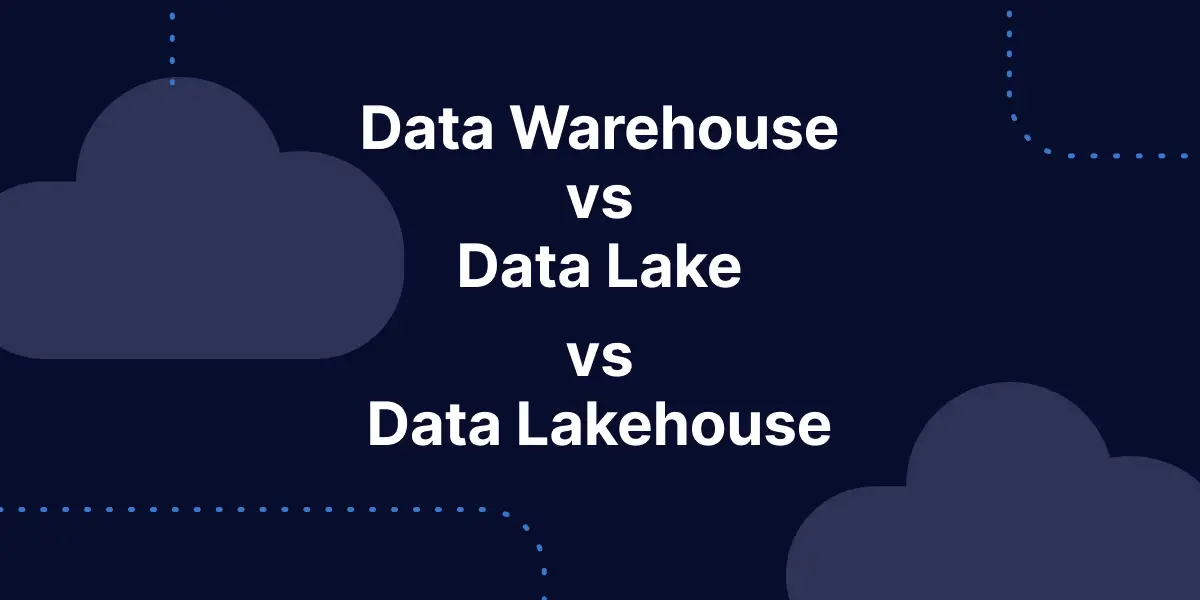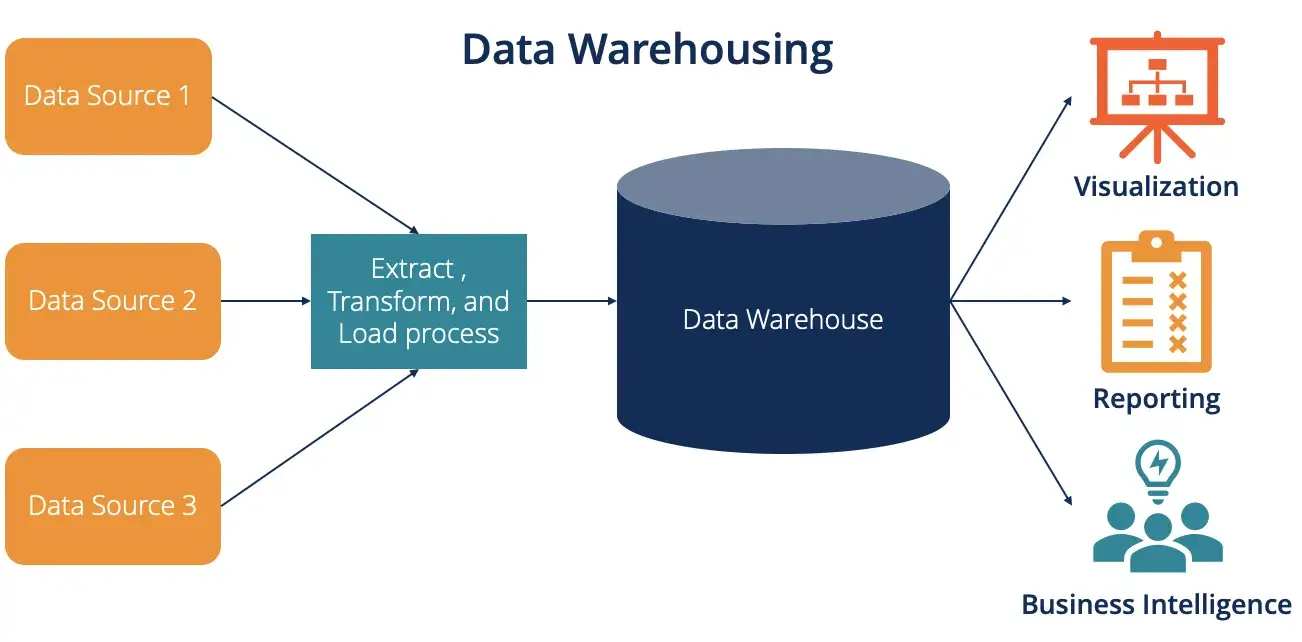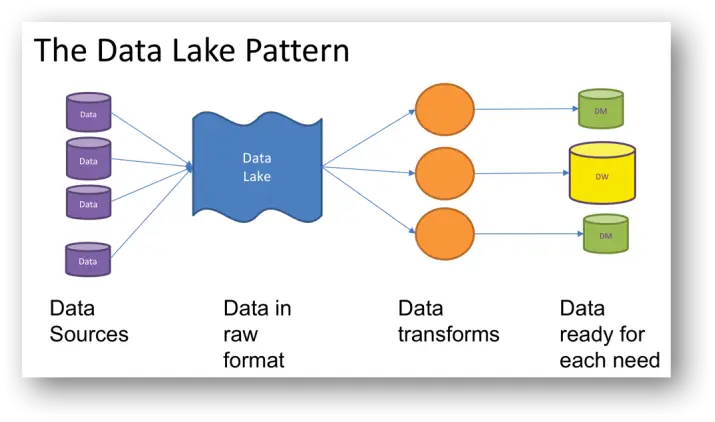
As more companies rely on data to drive critical business decisions, improve product offerings, and serve customers better, the amount of data companies capture is higher than ever. This study by Domo estimates 2.5 quintillion bytes of data were generated every day in 2017, with this figure set to increase to 463 exabytes in 2025. But what good is all that data if companies can’t utilize it quickly? The topic of the most optimal data storage for data analytics needs has been long debated.
Data warehouses and data lakes have been the most widely used storage architectures for big data. But what about using a data lakehouse vs. a data warehouse? A data lakehouse is a new data storage architecture that combines the flexibility of data lakes and the data management of data warehouses.
Depending on your company’s needs, understanding the different big-data storage techniques is instrumental to developing a robust data storage pipeline for business intelligence (BI), data analytics, and machine learning (ML) workloads.
- What is a Data Warehouse?
- What is a Data Lake?
- What is a Data Lakehouse? A Combined Approach
- Data Warehouse vs. Data Lake vs. Data Lakehouse: A Quick Overview
- Data Lakehouse vs. Data Warehouse vs. Data Lake: Which One Is Right for Your Needs?
What Is a Data Warehouse?
A data warehouse is a unified data repository for storing large amounts of information from multiple sources within an organization. A data warehouse represents a single source of “data truth” in an organization and serves as a core reporting and business analytics component.
Typically, data warehouses store historical data by combining relational data sets from multiple sources, including application, business, and transactional data. Data warehouses extract data from multiple sources and transform and clean the data before loading it into the warehousing system to serve as a single source of data truth. Organizations invest in data warehouses because of their ability to quickly deliver business insights from across the organization.
Data warehouses enable business analysts, data engineers, and decision-makers to access data via BI tools, SQL clients, and other less advanced (i.e., non-data science) analytics applications.

The benefits of a data warehouse
Data warehouses, when implemented, offer tremendous advantages to an organization. Some of the benefits include:
- Improving data standardization, quality, and consistency: Organizations generate data from various sources, including sales, users, and transactional data. Data warehousing consolidates corporate data into a consistent, standardized format that can serve as a single source of data truth, giving the organization the confidence to rely on the data for business needs.
- Delivering enhanced business intelligence: Data warehousing bridges the gap between voluminous raw data, often collected automatically as a matter of practice, and the curated data that offers insights. They serve as the data storage backbone for organizations, allowing them to answer complex questions about their data and use the answers to make informed business decisions.
- Increasing the power and speed of data analytics and business intelligence workloads: Data warehouses speed up the time required to prepare and analyze data. Since the data warehouse’s data is consistent and accurate, they can effortlessly connect to data analytics and business intelligence tools. Data warehouses also cut down the time required to gather data and give teams the power to leverage data for reports, dashboards, and other analytics needs.
- Improving the overall decision-making process: Data warehousing improves decision-making by providing a single repository of current and historical data. Decision-makers can evaluate risks, understand customers’ needs, and improve products and services by transforming data in data warehouses for accurate insights.
For example, Walgreens migrated its inventory management data into Azure Synapse to enable supply chain analysts to query data and create visualizations using tools such as Microsoft Power BI. The move to a cloud data warehouse also decreased time-to-insights: previous-day reports are now available at the start of the business day, instead of hours later.
The disadvantages of a data warehouse
Data warehouses empower businesses with highly performant and scalable analytics. However, they present specific challenges, some of which include:
- Lack of data flexibility: Although data warehouses perform well with structured data, they can struggle with semi-structured and unstructured data formats such as log analytics, streaming, and social media data. This makes it hard to recommend data warehouses for machine learning and artificial intelligence use cases.
- High implementation and maintenance costs: Data warehouses can be expensive to implement and maintain. This article by Cooladata estimates the annual cost of an in-house data warehouse with one terabyte of storage and 100,000 queries per month to be $468,000. Additionally, the data warehouse is typically not static; it becomes outdated and requires regular maintenance, which can be costly.
What Is a Data Lake?
A data lake is a centralized, highly flexible storage repository that stores large amounts of structured and unstructured data in its raw, original, and unformatted form. In contrast to data warehouses, which store already “cleaned” relational data, a data lake stores data using a flat architecture and object storage in its raw form. Data lakes are flexible, durable, and cost-effective and enable organizations to gain advanced insight from unstructured data, unlike data warehouses that struggle with data in this format.
In data lakes, the schema or data is not defined when data is captured; instead, data is extracted, loaded, and transformed (ELT) for analysis purposes. Data lakes allow for machine learning and predictive analytics using tools for various data types from IoT devices, social media, and streaming data.

The benefits of a data lake
Because data lakes can store both structured and unstructured data, they offer several benefits, such as:
- Data consolidation: Data lakes can store both structured and unstructured data to eliminate the need to store both data formats in different environments. They provide a central repository to store all types of organizational data.
- Data flexibility: A significant benefit of data lakes is their flexibility; you can store data in any format or medium without the need to have a predefined schema. Allowing the data to remain in its native format allows for more data for analysis and caters to future data use cases.
- Cost savings: Data lakes are less expensive than traditional data warehouses; they are designed to be stored on low-cost commodity hardware, like object storage, usually optimized for a lower cost per GB stored. For example, Amazon S3 standard object storage offers an unbelievable low price of $0.023 per GB for the first 50 TB/month.
- Support for a wide variety of data science and machine learning use cases: Data in data lakes is stored in an open, raw format, making it easier to apply various machine and deep learning algorithms to process the data to produce meaningful insights.
The disadvantages of a data lake
Although data lakes offer quite a few benefits, they also present challenges:
- Poor performance for business intelligence and data analytics use cases: If not properly managed, data lakes can become disorganized, making it hard to connect them with business intelligence and analytics tools. Also, a lack of consistent data structure and ACID (atomicity, consistency, isolation, and durability) transactional support can result in sub-optimal query performance when required for reporting and analytics use cases.
- Lack of data reliability and security: Data lakes’ lack of data consistency makes it difficult to enforce data reliability and security. Because data lakes can accommodate all data formats, it might be challenging to implement proper data security and governance policies to cater to sensitive data types.
What Is a Data Lakehouse? A Combined Approach
A data lakehouse is a new, big-data storage architecture that combines the best features of both data warehouses and data lakes. A data lakehouse enables a single repository for all your data (structured, semi-structured, and unstructured) while enabling best-in-class machine learning, business intelligence, and streaming capabilities.
Data lakehouses usually start as data lakes containing all data types; the data is then converted to Delta Lake format (an open-source storage layer that brings reliability to data lakes). Delta lakes enable ACID transactional processes from traditional data warehouses on data lakes.
The benefits of a data lakehouse
Data lakehouse architecture combines a data warehouse’s data structure and management features with a data lake’s low-cost storage and flexibility. The benefits of this implementation are enormous and include:
- Reduced data redundancy: Data lakehouses reduce data duplication by providing a single all-purpose data storage platform to cater to all business data demands. Because of the advantages of the data warehouse and the data lake, most companies opt for a hybrid solution. However, this approach could lead to data duplication, which can be costly.
- Cost-effectiveness: Data lakehouses implement the cost-effective storage features of data lakes by utilizing low-cost object storage options. Additionally, data lakehouses eliminate the costs and time of maintaining multiple data storage systems by providing a single solution.
- Support for a wider variety of workloads: Data lakehouses provide direct access to some of the most widely used business intelligence tools (Tableau, PowerBI) to enable advanced analytics. Additionally, data lakehouses use open-data formats (such as Parquet) with APIs and machine learning libraries, including Python/R, making it straightforward for data scientists and machine learning engineers to utilize the data.
- Ease of data versioning, governance, and security: Data lakehouse architecture enforces schema and data integrity making it easier to implement robust data security and governance mechanisms.
The disadvantages of a data lakehouse
The main disadvantage of a data lakehouse is it’s still a relatively new and immature technology. As such, it’s unclear whether it will live up to its promises. It may be years before data lakehouses can compete with mature big-data storage solutions. But with the current speed of modern innovation, it’s difficult to predict whether a new data storage solution could eventually usurp it.
Data Warehouse vs. Data Lake vs. Data Lakehouse: A Quick Overview
The data warehouse is the oldest big-data storage technology with a long history in business intelligence, reporting, and analytics applications. However, data warehouses are expensive and struggle with unstructured data such as streaming and data with variety.
Data lakes emerged to handle raw data in various formats on cheap storage for machine learning and data science workloads. Though data lakes work well with unstructured data, they lack data warehouses’ ACID transactional features, making it difficult to ensure data consistency and reliability.
The data lakehouse is the newest data storage architecture that combines the cost-efficiency and flexibility of data lakes with data warehouses’ reliability and consistency.
This table summarizes the differences between the data warehouse vs. data lake vs. data lakehouse.
| Data Warehouse | Data Lake | Data Lakehouse | |
|---|---|---|---|
| Storage Data Type | Works well with structured data | Works well with semi-structured and unstructured data | Can handle structured, semi-structured, and unstructured data |
| Purpose | Optimal for data analytics and business intelligence (BI) use-cases | Suitable for machine learning (ML) and artificial intelligence (AI) workloads | Suitable for both data analytics and machine learning workloads |
| Cost | Storage is costly and time-consuming | Storage is cost-effective, fast, and flexible | Storage is cost-effective, fast, and flexible |
| ACID Compliance | Records data in an ACID-compliant manner to ensure the highest levels of integrity | Non-ACID compliance: updates and deletes are complex operations | ACID-compliant to ensure consistency as multiple parties concurrently read or write data |
The “data lakehouse vs. data warehouse vs. data lake” is still an ongoing conversation. The choice of which big-data storage architecture to choose will ultimately depend on the type of data you’re dealing with, the data source, and how the stakeholders will use the data. Although a data lakehouse combines all the benefits of data warehouses and data lakes, we don’t advise you to throw your existing data storage technology out the window for a data lakehouse.
Data Lakehouse vs. Data Warehouse vs. Data Lake: Which One Is Right for Your Needs?
Data lakehouses can be complex to build from scratch. And you’ll most likely use a platform built to support open data lakehouse architecture. So, ensure you research each platform’s different capabilities and implementations before making a purchase.
A data warehouse is a good choice for companies seeking a mature, structured data solution that focuses on business intelligence and data analytics use cases. However, data lakes are suitable for organizations seeking a flexible, low-cost, big-data solution to drive machine learning and data science workloads on unstructured data.
Suppose the data warehouse and data lake approaches aren’t meeting your company’s data demands, or you’re looking for ways to implement both advanced analytics and machine learning workloads on your data. In that case, a data lakehouse is a reasonable choice.
Whichever solution you choose, Striim can help. Striim makes it simple to continuously and non-intrusively ingest all your enterprise data from various sources in real-time for data warehousing. Striim can also be used to preprocess your data in real-time as it is being delivered into the data lake stores to speed up downstream activities.
Schedule a demo and we’ll give you a personalized walkthrough or try Striim at production-scale for free! Small data volumes or hoping to get hands on quickly? At Striim we also offer a free developer version.





















